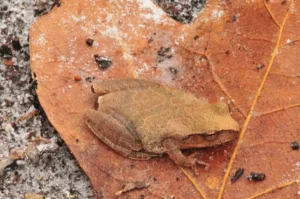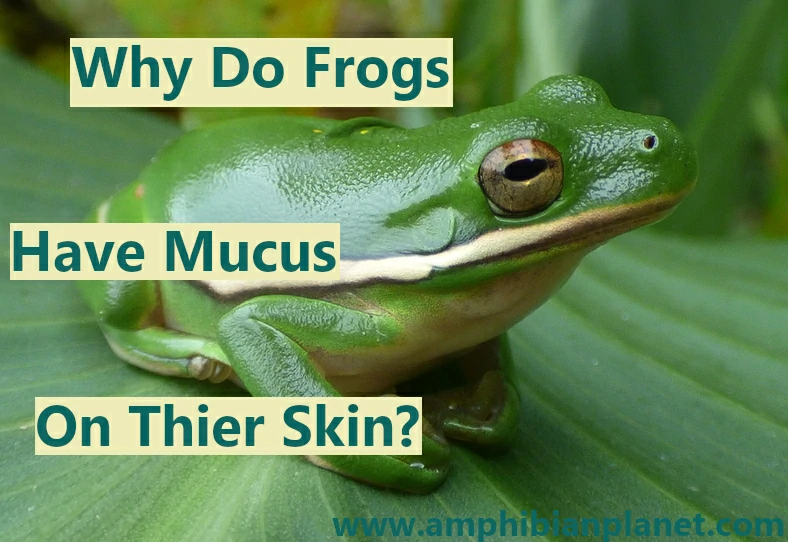Amphibians have unique skin compared to that of many other vertebrates. They use their skin to breathe, and also to ‘drink’ water.
Many frogs feel slimy because their skin is covered in a mucous coating, which helps them keep their skin moist, enabling them to efficiently breathe through their skin. The slime also creates an environment for bacteria and microscopic fungi to live. These microbiomes help defend frogs against disease, infection, and more.
That said, it’s important to note that not all frog species have moist, slimy skin. Some frog species such as the Waxy monkey leaf frog (Phyllomedusa sauvagii) of South America live in very arid environments.
For this reason, these frogs secrete a lipid coating to limit water loss through the skin. These lipid secretions give Waxy monkey leaf frogs a waxy, rather than slimy feeling (hence their name).
Many toad species have dry, bumpy skin, rather than the smooth skin that frogs have.
Frog Slime Helps Keep Their Skin Moist
As earlier mentioned, amphibians have unique skin compared to that of many other vertebrates. Their skin is composed of thin membranous tissue that is quite permeable to water and contains a large network of blood vessels.
This permeable skin distinguishes them from mammals, birds, or reptiles.
Permeability relates to how easily a gas or liquid molecule can pass back and forth from the environment into the animal and vice versa.
Typically, the larger the molecule, the more difficult it is to enter the animal through its skin. Amphibian skin is more permeable than that of other vertebrates.
Their membranous skin allows water and respiratory gases to readily diffuse directly down their gradients between the blood vessels and the surroundings.
To efficiently breathe, frogs have to keep their skin constantly moist by secreting a special mucous coating (which gives them a slimy feeling when touched).

The mucus that frogs secrete traps moisture next to the skin. This moisture then transfers oxygen into the frog’s bloodstream and allows carbon dioxide to diffuse out. This process is called cutaneous gas exchange.
Frogs can only breathe through their skin if the skin stays moist. If it dries up, they can suffocate and die.
Frog slime is also a conducive environment for bacteria and microscopic fungi to live. These microbiomes are extremely beneficial and can defend frogs against disease, infection, and more.
A component of the skin mucus secreted by South Indian frogs (Hydrophylax bahuvistara) is even known to kill the H1 variety of influenza viruses!
How Is Frog Slime Produced?
Amphibians tend to have more glands in their skin than other vertebrates. The most important glands are the granular and mucus glands.
In poisonous frogs (such as the Cuban tree frog), the poison is produced in the granular glands, and secreted over the skin as a defense against predators.
Mucus glands are much more numerous in amphibian skin than the granular glands and are responsible for producing the mucus coating.
Other Functions Of Frog Skin
Apart from gas exchange, frog skin has other important functions:
1. Water Absorption
Frogs need to consume water to survive. Dehydration can be harmful, and even potentially lethal to most frogs. Their need for water is as critical as their need for food or oxygen–it’s an essential substance, that keeps their bodies working normally.
Frogs generally do not drink water through their mouths as humans do, but instead, acquire water by absorption across their skin in a process known as ‘cutaneous absorption’.
Although most of a frogs’ skin is permeable to water, many frogs have a specialized area of skin located on their belly and the underside of their thighs (the ventral pelvic region), known as the ‘drink patch’, ‘drinking patch’, or the ‘seat patch’. This area of skin is responsible for most of their water uptake.
The drink patch has a very large network of small blood vessels called capillaries. Water absorption across this skin is driven by the osmotic gradient that develops as a consequence of solute transport.
In simple words, the skin acts in concert with the kidneys and urinary bladder to maintain fluid balance.
Even though the drink patch skin only constitutes about ten percent of the total skin area, it is responsible for over 70 percent of the total water uptake by many dehydrated frogs.
2. Camouflage
Frogs have several ways to defend themselves from predators. Some frogs such as the Pickerel frog produce skin secretions that are toxic or distasteful to many predators.
Animals that try to eat one of these frogs, will get a mouthful of foul-tasting toxin, and spit the frog out. If an animal eats a poisonous frog, it may get sick, or even die (depending on how toxic the frog species is).
Some frogs do not have any toxic skin secretions and instead rely on the coloration of their skin camouflage or blend into the leaves and other debris in their environments, escaping the notice of most predators.

Some frogs, such as the Spring peeper (Pseudacris crucifer), have a coloration that helps them blend into their environments.
Frogs such as the Gray tree frog (Hyla versicolor), are even capable of rapidly changing color, based on their surroundings – much like a chameleon.
3. Protection Against The External Environment
Much like in humans, frogs’ skin is the first line of defense against the external environment. It acts as the first physical barrier to withstand any pressure, stress, or trauma.
The epidermal and dermal layers of frog skin help protect them from the elements, although frogs are highly sensitive to contaminants in their environments.
Some frog species, such as those of the genus Cyclorama, build ‘skin cocoons’ to reduce water loss from the skin while they aestivate in the summer.
At the beginning of aestivation, these frogs shed their skin cells, which form a thin sheet around the body. Several sheets eventually make the cocoon.
Initially, the cocoon is thin and transparent. However, as time progresses, more layers are added and the cocoon gradually becomes thicker and opaque, with tightly packed layers of dead epidermal skin cells.
The cocoon covers the entire body surface, eyes, mouth, and cloacal opening, except the nasal openings. This allows the aestivating frogs to breathe air.
When the frogs emerge from aestivation, the frogs will come out of their cocoons and resume their activity.
Not All Frogs Have Slimy Skin
Although most frogs have smooth, moist skin with a slimy mucus coating not all do.
Many toads have dry, dumpy skin with a leathery texture. Usually, the largest of the bumps on a toad’s skin are those that cover the parotid glands, just behind the eyes. The bumps are commonly called warts.
Since toads do not need to keep their skin moist, they can live in habitats further away from water sources than most true frogs.
A few toad species, such as the Green toad (Bufo viridi) are more tolerant to arid conditions than many other amphibians.

These toads can tolerate extremely high temperatures of 40°C (104°F). They are also quite tolerant to desiccation and can withstand losing up to 50% of their body water (they only die when they lose more than 50% of their body water).
Another frog species with tolerance to arid conditions is the waxy monkey leaf frog (Phyllomedusa sauvagii) of South America.
These frogs can tolerate a wide range of body temperatures about 20 (68°F) and 40°C (104°F). Waxy monkey leaf frogs limit water loss through the skin by lipid secreting a lipid coating over their skin and excretion of uric acid.
These lipid secretions give the skin of waxy monkey leaf frogs a waxy, rather rather than slimy feeling (hence their name).
Common Questions About Frog Slime
Why do frogs have mucus on their skin? Frogs have mucus on their skin to enable efficient gaseous exchange across the skin surface. they can breathe through their skin.
The mucus traps moisture next to the skin. This moisture then enables oxygen to diffuse into the frog’s bloodstream and carbon dioxide to diffuse out, in a process called ‘cutaneous gas exchange.’
Frogs can only breathe through their skin if the skin stays moist. If it dries up, they can suffocate and die.
The mucus frogs secrete on their skin is also a conducive environment for bacteria and microscopic fungi to live. These microbiomes are extremely beneficial and can defend frogs against disease, infection, and more.
Why do frogs secrete mucus? Frogs secrete a mucus coating on their skin to keep their skin moist. This enables them to efficiently breathe through their skin. If a frog’s skin dries up, it can suffocate and die. The mucus is also a conducive environment for bacteria and microscopic fungi to live. These microbiomes help defend frogs against disease, infection, and more.
Sources:
K. Lee E. H. Mercer, Cocoon Surrounding Desert-Dwelling Frogs.Science157,87-88 (1967). DOI: 10.1126/science.157.3784.87
Christopher R. Tracy, Stephen J. Reynolds, Lorrae McArthur, C. Richard Tracy, and Keith A. Christian “Ecology of Aestivation in a Cocoon-forming Frog, Cyclorana Australis (Hylidae),” Copeia 2007(4), 901-912, (28 December 2007). https://doi.org/10.1643/0045-8511(2007)7[901:EOAIAC]2.0.CO;2
Malcolm S. Gordon; Osmotic Regulation in the Green Toad (Bufo Viridis). J Exp Biol 1 June 1962; 39 (2): 261–270. doi: https://doi.org/10.1242/jeb.39.2.261
AmphibiaWeb. Bufotes viridis Green Toad. University of California, Berkeley, CA, USA.
AmphibiaWeb. Phyllomedusa sauvagi Waxy Monkey Tree Frog. University of California, Berkeley, CA, USA.
ScienceNews. Frog slime protein fights off the flu.


